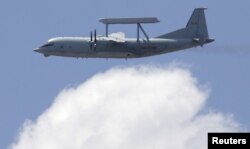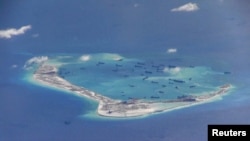The United States is downplaying the severity of what is being described as a “close encounter” between U.S. and Chinese military aircraft over the South China Sea.
“We don't see any evidence that this was intentional,” Pentagon spokesman Captain Jeff Davis said Friday, describing the incident as a “one-off.”
According to U.S. officials, during Wednesday's encounter, a Chinese KJ-200 early warning aircraft passed about 200 meters (1,000 feet) in front of a U.S. Navy P-3 plane on a routine mission in international airspace near Scarborough Shoal, between the Chinese mainland and the Philippines. As a result, the P-3 was forced to make an immediate turn.
Both planes were in “normal radio contact” following the incident, Davis said, describing the communications as “professional.”
Close call was accidental
Despite the early indications that incident was accidental, the Pentagon says it will still be reviewed, and that U.S. military officials would be in contact with their appropriate Chinese counterparts.
“Clearly we have our disagreements with China over militarization of the South China Sea, over their reclamation of the islands and some of their broader strategic objectives,” Davis said. “But when it comes to simply the [military] interactions, those are largely professional and safe.”
The close encounter between the two aircraft comes as tensions between the U.S. and China are heightened because of China's moves to create man-made islands in the South China Sea.
A message from China?
In an interview, Dr. Thomas G. Mahnken, president of the Center for Strategic and Budgetary Assessments, told VOA that while there is an effort by the Chinese to exert control over the South China Sea and treat it like Chinese airspace, it's important to acknowledge that pilots do sometimes make mistakes.
“If we look at the totality of Chinese behavior, it's some mixture of those two things, and the challenge for American policymakers and American soldiers is to disentangle what's deliberate and what is unprofessional,” he said. “We don't want to lump in a deliberate behavior with unprofessional, poor piloting.”
Mahnken said he thinks the Chinese are trying to create an atmosphere where U.S. officials tacitly acknowledge that large parts of the international waters in the South China Sea are Chinese territory.
“They want us to avoid operating in and near these artificial features they've created,” Mahnken said, referring to man-made islands erected by the Chinese as military bases near the Philippines.
It is important, Mahnken said, for the U.S. to remind the Chinese that under international law, the islands “do not exist.”
“It's perfectly legitimate for the United States, and in accordance with our long-standing policy, to essentially treat those man-made features for what they are: They're hazards to navigation. They're not Chinese sovereign territory,” he said. “So we should operate around, above, near those man-made features routinely, limited only by the safety of our ships and the safety of our aircraft.”
VOA's Mandarin service contributed to this story.










